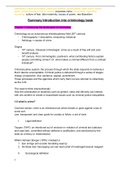Definitions, crime and media, crime and politics, social justice, ideal victim, moral
panic, penal populism, trial by media, corporate crime, recognition, reporting,
recording, culture of fear, late modernity, issues of power, neo-liberalism
Summary Introduction into criminology book
Chapter 1: introducing the landscapes of criminology
Criminology as an autonomous interdisciplinary field (20 th century)
- Criminography = descriptive, measuring, historical
- Aetiology = causes of crime
Origins
- 18th century: Classical criminologist: crime as a result of free will and cost-
benefit analysis
- 19th century: First criminologists: positivism: what contributing factors explain
people committing crimes? Or: what makes a criminal different from a civilized
individual?
Criminal justice system: the process through which the state responds to behaviour
that it deems unacceptable. Criminal justice is delivered through a series of stages:
charge, prosecution, trial, sentence, appeal, punishment.
These processes and the agencies which carry them out are referred to collectively
as the CJS.
The need to think intersectionally:
How the combination of dynamics such as gender, class and ethnicity can interact
with one another to create or exacerbate issues such as criminal justice inequalities.
1.6 what is crime?
Common-sense: crime is an intentional act which breaks or goes against a law of
some sort.
Law: transparent and clear guide for society to follow: a set of tools
I. Legal definition
Tappan (1947): an intentional act of omission in violation of criminal law (statutory
and case law), committed without defense or justification, and sanctioned by the
state as a felony or misdemeanor.
Willem Adriaan Bonger (1876): misdaad is
1. Een erntige anti-sociale handeling waarop
2. De Staat door toevoeging van een leed (straf of maatregel) bewust reageert
II. Sociological definition
1
,Definitions, crime and media, crime and politics, social justice, ideal victim, moral
panic, penal populism, trial by media, corporate crime, recognition, reporting,
recording, culture of fear, late modernity, issues of power, neo-liberalism
Sellin (1938): we need a scientific (not legal) criminology, and a scientific definition of
crime.
We need to search for universalities in norms and rule transgression: what things do
societies generally believe to be ‘wrong’?: there is a moral and social component in
crime. In this field, deviant behaviour is a topic of study.
- Crime is what society believes to be immoral and anti-social: deviant. Based
on norms and rule transgression
III. Social constructivist definition
Becker (1963): why is some behaviour criminalized, and other not?
Crime is the ‘product of the dynamics of a given society’.
Social groups create deviance themselves: by making rules whose violation creates
deviance, and by applying those rules to particular people and labeling them as
outsiders. Crime is behaviour so defined by the agents and activities of the powerful.
Abolitionism (Hulsman, 1986)
Categories of ‘crime’ are given by the criminal justice system rather than by victims of
society in general. This makes it necessary to abandon the notion of ‘crime’ as a tool
in the conceptual framework of criminology. Crime has no reality and is not the object
but the product of criminal policy.
IV. Human rights definition
Schwendiger & Schwendiger (1970): social justice. Human rights as a threshold:
non-respect/violation of these rights constitutes crime.
- Imperialism, racism, sexism, poverty
V. Harm definition
Lynch (1992); Beirne & South (1998); Hillyard & Tombs (2007):
Crime is a legal construct (power!) and is anthropocentric (too much focused on the
human species).
‘Crime’ is the harms done to the environment, animals, etc.
Conclusion lecture 1:
- What constitutes ‘crime’ depends on the definition used.
- The power struggles at play
- The time and place
- The definition of crime is, thus, situational.
2
, Definitions, crime and media, crime and politics, social justice, ideal victim, moral
panic, penal populism, trial by media, corporate crime, recognition, reporting,
recording, culture of fear, late modernity, issues of power, neo-liberalism
The morals and social context of crime
Morals influence the society’s view on deviancy, which can shape legislation.
On the other hand, legislation can also shape society’s view on morals and deviancy.
- Change of social attitudes
- Socially constructed nature of crime: product of the dynamics of a society at a
given point in time
- Morals view on deviancy legislation view on morals
- Example: rape within marriage was made legal in 1991, smoking inside
New wine or old wine in a new bottle:
Is the act being committed fundamentally a new act of crime, or is it simply an older
act occurring through a new medium? (Cybercrime - hate crime)
Chapter 5: counting crime
Counting crime: what do we count?
How crime is defined impacts on what exactly is measured, and how. The matter of
counting crime, including harms, thus becomes a subjective process.
Official data often use the legal definition of crime. Within this, if we take a single
counting measure like official data, the actual processes employed to count crime
have changed over time. That is, there have been different criteria used:
- different categories of crime,
- the changing law leads to the inclusion/exclusion of certain behaviours,
- different priorities and competencies of the police detecting and responding to
behaviours.
Crime mapping: the police can plot incidents against geographic areas and times, to
determine hot-spots and thus direct resources accordingly in order to tackle crime
How do we count crime?
1. official data (from agencies who have direct involvement with law and order
issues)
- Police recorded data
- Recorded by police and courts
- A stark rise in counted crime does not indicate that society has become more
dangerous per se.
o Rise and fall in crime can be linked to explanations for offending (like
economic downturn/social conditions), and different approaches taken
by the police to the counting and recording of crime
3






